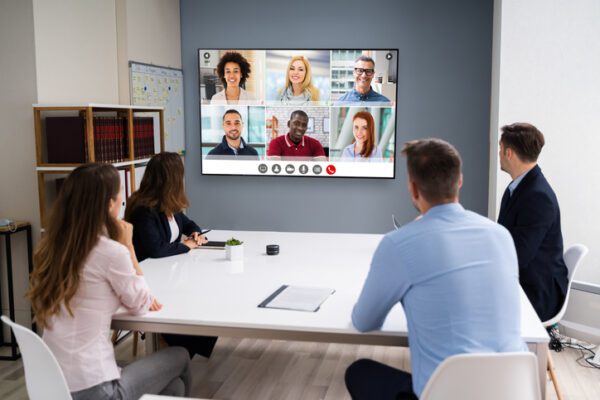
Huddle rooms are different from more conventional collaborative spaces found in office environments. When someone uses the words “conference room,” we think of board rooms—the formal spaces where people cluster around a table for lengthy discussions. Technology is limited to presentations and conference calls. In rare cases, there may be video conferencing capabilities.
Also, conference rooms connote planning since most must be reserved. But what if your team needs a collaborative space for a quick, unplanned discussion? Do you wander the halls looking for an open conference room, or do you crowd into someone’s office? Cubicles or community spaces won’t work because the discussion is sensitive. This is where huddle rooms come in.
What Is a Huddle Room?
Huddle spaces combine two diverse concepts:
- Standup meetings from agile development
- Cluster discussions from sports
Many agile organizations hold daily 15-minute meetings to keep team members informed. People typically stand for these updates to keep the time below 15 minutes. Similarly, sports huddles are quick discussions (lasting less than five minutes) that outline the next steps or strategies. Baseball huddles happen at the pitcher’s mound, while football huddles happen after every down.
The third element of huddle meetings is huddle room technology. With hybrid work environments becoming more commonplace, companies need better video conferencing and virtual meeting tools. In addition, they must leverage collaboration and team-building tools to create an inclusive environment.
What Makes a Huddle Room?
Huddle designs create a comfortable and welcoming environment. Furniture is grouped to encourage conversation. Seating for a group of four or five people with a flat space for laptops should form the basis of a huddle space. Chairs should also be arranged so as not to invade anyone’s personal space.
Natural lighting works best. But if it’s not an option, consider softer lighting that mimics nature. In some instances, the room may need darkening capabilities to improve visibility.
Consider these elements:
Audio
Huddle room technology begins with acoustics. Nothing is more frustrating than a virtual meeting where participants can’t hear. So look for conference room sound systems that use professional-grade microphones and speakers that can switch from voice to recordings without losing audio.
Visual

Huddles are great—unless the huddle is around a laptop. Screen-sharing and split-screen displays are crucial for hybrid meetings. Without video technologies, participants spend more time trying to see what is being discussed than actually brainstorming solutions.
Displays should fit the room. Displays over 50 inches, for example, will overpower a small room. Huddle space design should facilitate discussions. Mounting all displays at eye level allows for a more natural face-to-face discussion.
Voice
Huddle room video conferencing requires equipment that can dampen external noise to keep communications clear. They should be sized to the room so the volume is not overpowering or so low people struggle to hear. For huddle rooms to work, the huddle room technology must meet everyone’s needs and be easy to use.
When conference calls are needed, the sound system must ensure clear audio with no external disruptions. Momentum can quickly die if individuals have to repeat themselves. Also, some ideas may be missed.
Text
Huddle sessions are often brainstorming meetings that sometimes require a picture rather than words. Having a writing wall in a huddle environment makes it easier to visualize what someone is discussing. It may be a traditional whiteboard or a contemporary glass wall, but a huddle room needs a way to share writing in real time.
Why Have a Huddle Room?
Huddle spaces address the growing need for collaborative interactions. Companies benefit from these smaller spaces that require less square footage. They encourage team-building by providing tools to facilitate innovation and promote inclusiveness through remote capabilities.
Conference rooms will still exist for more formal and structured meetings. After all, board meetings will still require conference tables that fit 15 or 20 people. These spaces will also need technology to support the more formal discussions.
With the right huddle room technology partner, organizations can create huddle spaces for those unplanned collaborations that lead to innovation and still maintain conference rooms for more formal meetings. Moffitt Technology has the experience and expertise to help organizations design huddle rooms that invite interaction. Contact us today to discuss your huddle room needs.

